Intel Architecture Day 2021: Alder Lake, Golden Cove, and Gracemont Detailed
by Dr. Ian Cutress & Andrei Frumusanu on August 19, 2021 9:00 AM EST
This week Intel held its annual Architecture Day event for select press and partners. As with previous iterations, the company disclosed details about its next generation architectures set to come to the market over the next twelve months. Intel has promised the release of its next-generation consumer and mobile processor family, Alder Lake, to come by the end of the year and today the company is sharing a good number of details about the holistic design of the chips as well as some good detail about the microarchitectures that form this hybrid design: Golden Cove and Gracemont. Here is our analysis of Intel’s disclosure.
Alder Lake: Intel 12th Gen Core
As mentioned in previous announcements, Intel will launch its Alder Lake family of processors into both desktop and mobile platforms under the name of Intel’s 12th Gen Core Processors with Hybrid Technology later this year. This is Intel’s second generation hybrid architecture built on Intel 7 process node technology. The hybrid design follows Intel Lakefield designs for small notebooks launched last year. The nature of a hybrid design in Intel nomenclature involves having a series of high ‘Performance’ cores paired with a number of high ‘Efficiency’ cores. Intel has simplified this into P-core and E-core terminology.
For Alder Lake, the processor designs feature Performance cores based on a new Golden Cove microarchitecture, and Efficiency cores based on a new Gracemont architecture. We will cover both over the course of this article, however the idea is that the P-core is preferential for single threaded tasks that require low latency, and the E-core is better in power limited or multi-threaded scenarios. Each Alder Lake SoC will physically contain both, however Intel has not yet disclosed the end-user product configurations.
Each of the P-cores has the potential to offer multithreading, whereas the E-cores are one thread per core. This means there will be three physical designs based on Alder Lake:
- 8 P-core + 8 E-core (8C8c/24T) for desktop on a new LGA1700 socket
- 6 P-core + 8 E-core (6C8c/20T) for mobile UP3 designs
- 2 P-core + 8 E-core (2C8c/12T) for mobile UP4 designs
Intel typically highlights UP4 mobile designs for very low power installs, down to 9 W, whereas UP3 can cover anything from 12 W to 35 W (or perhaps higher), but when asked about the power budgets for these processors, Intel stated that more detail will follow when product announcements are made. Intel did confirm that the highest client power, presumably on the desktop processor, will be 125 W.
Highlighted in our discussions is how modular Intel has made Alder Lake. From a range of base component options, the company mixed and matched what it felt were the best combination of parts for each market.
Here it shows that four E-cores takes up the same physical space as one P-core, but also that the desktop hardware will at most have 32 EUs (Execution Units) for Xe-LP graphics (same as the previous generation), while both of the mobile processors will offer 96 physical EUs that may be disabled down based on the specific line item in the product stack.
All three processors will feature Intel’s next generation Gaussian Neural Accelerator (GNA 3.0) for minor low power AI tasks, a display engine, and some level of PCIe, however the desktop processor will have more. Only the mobile processors will get an Image Processing Unit (IPU), and Thunderbolt 4 (TBT), and here the big UP3 mobile processor gets four ports of Thunderbolt whereas the smaller UP4 will only get two. The desktop processor will not have any native Thunderbolt connectivity.
A bit more info on the Desktop Processor IO and Interconnect
We’ll cover a bit more detail about the core designs later in this article, but Intel did showcase some of the information on the desktop processor. It confirmed explicitly that there would be 16 total cores and 24 threads, with up to 30 MB of non-inclusive last level/L3 cache.
In contrast to previous iterations of Intel’s processors, the desktop processor will support all modern standards: DDR5 at 4800 MT/s, DDR4-3200, LPDDR5-5200, and LPDDR4X-4266. Alongside this the processor will enable dynamic voltage-frequency scaling (aka turbo) and offer enhanced overclocking support. What exactly that last element means we’re unclear of at this point.
Intel confirmed that there will not be separate core designs with different memory support – all desktop processors will have a memory controller that can do all four standards. What this means is that we may see motherboards with built-in LPDDR5 or LPDDR4X rather than memory slots if a vendor wants to use LP memory, mostly likely in integrated small form factor designs but I wouldn’t put it past someone like ASRock to offer a mini-ITX board with built in LPDDR5. It was not disclosed what memory architectures the mobile processors will support, although we do expect almost identical support.
On the PCIe side of things, Alder Lake’s desktop processor will be supporting 20 lanes of PCIe, and this is split between PCIe 4.0 and PCIe 5.0.
The desktop processor will have sixteen lanes of PCIe 5.0, which we expect to be split as x16 for graphics or as x8 for graphics and x4/x4 for storage. This will enable a full 64 GB/s bandwidth. Above and beyond this are another four PCIe 4.0 lanes for more storage. As PCIe 5.0 NVMe drives come to market, users may have to decide if they want the full PCIe 5.0 to the discrete graphics card or not
Intel also let it be known that the top chipset for Alder Lake on desktop now supports 12 lanes of PCIe 4.0 and 16 lanes of PCIe 3.0. This will allow for additional PCIe 4.0 devices to use the chipset, reducing the number of lanes needed for items like 10 gigabit Ethernet controllers or anything a bit spicier. If you ever thought your RGB controller could use more bandwidth, Intel is only happy to provide.
Intel did not disclose the bandwidth connectivity between the CPU and the chipset, though we believe this to be at least PCIe 4.0 x4 equivalent, if not higher.
The Alder Lake processor retains the dual-bandwidth ring we saw implemented in Tiger Lake, enabling 1000 GB/s of bandwidth. We learned from asking Intel in our Q&A that this ring is fully enabled regardless of whether the P-cores or E-cores are being used – Intel can disable one of the two rings when less bandwidth is needed, which would save power, however based on previous testing this single ring could end up drawing substantial power compared to the E-cores in low power operation. (This may be true in the mobile processors as well, which would have knock on effects for mobile battery life.)
The 64 GB/s of IO fabric is in line with the PCIe 5.0 x16 numbers we saw above, however the 204 GB/s of memory fabric bandwidth is a confusing number. Alder Lake features a 128-bit memory bus, which allows for 4x 32-bit DDR5 channels (DDR5 has two 32-bit channels per module, so 2 modules still), however in order to reach 204 GB/s in that configuration requires DDR5-12750; Intel has rated the processor only at DDR5-4800, less than half that, so it is unclear where this 204 GB/s number comes from. For perspective, Intel’s Ice Lake does 204.8 GB/s, and that’s a high-power server platform with 8 channels of DDR4-3200.
This final slide mentions TB4 and Wi-Fi 6E, however as with previous desktop processors, these are derived from controllers attached to the chipset, and not in the silicon itself. The mobile processors will have TBT integrated, but the desktop processor does not.
This slide also mentions Intel Thread Director, which we want to address on the next page before we get to the microarchitecture analysis.


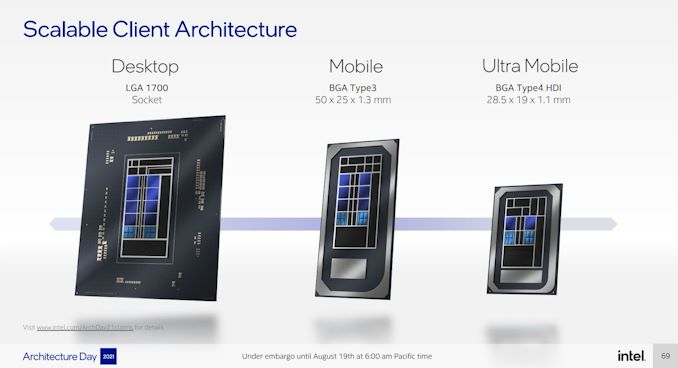

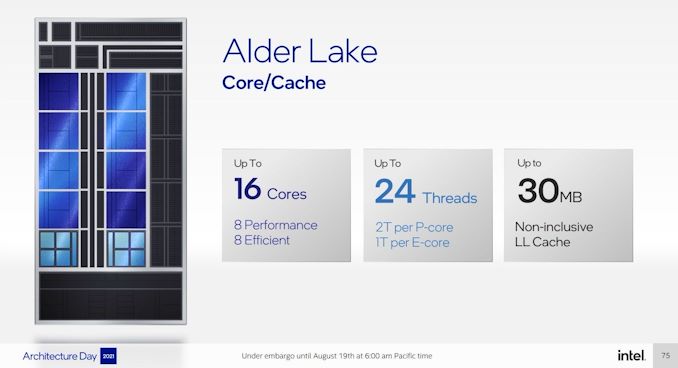
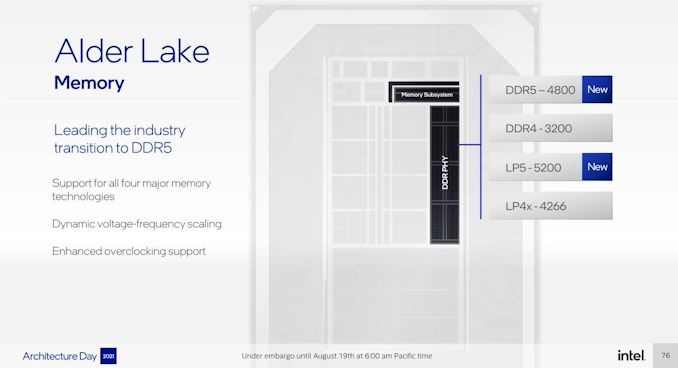
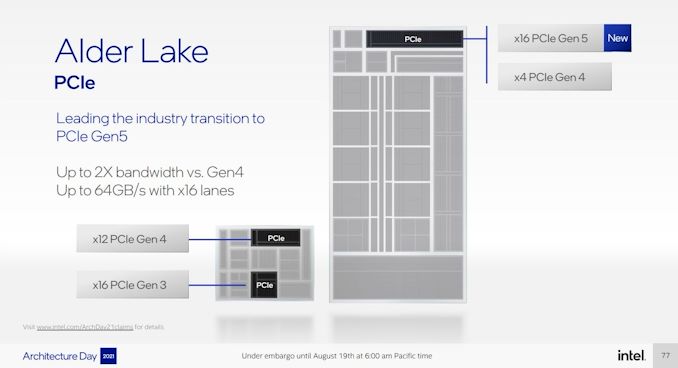
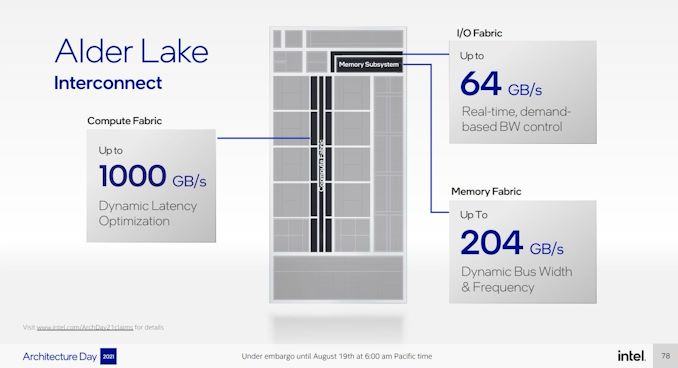
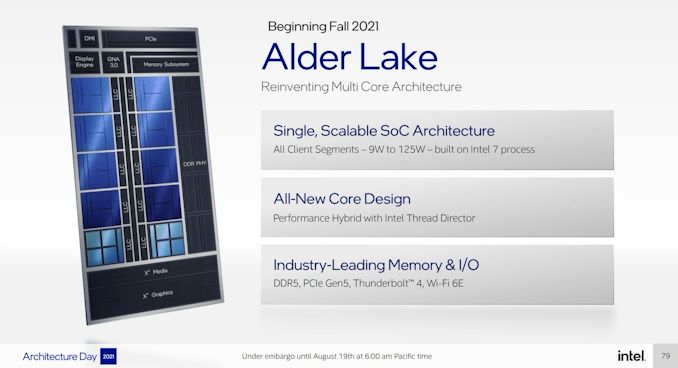








223 Comments
View All Comments
mode_13h - Saturday, August 21, 2021 - link
> micro-servers Big-little seems much more useful, but Intel typically has gone> a long way to ensure that 'desktop' CPUs were not used for that.
Huh? Their E-series Xeons are simply desktop CPUs with a few less features fused-off.
abufrejoval - Saturday, August 21, 2021 - link
We all know that that's what they are technically. But that didn't keep Intel from selling them, and the required chipsets, which had the same magical snake oil, at a heavy markup, before AMD came along and offered ECC and some RAS for free.And that is going to come back, as soon as Intel sees a chance to make an extra buck.
mode_13h - Sunday, August 22, 2021 - link
> that didn't keep Intel from selling them, and the required chipsets, ... at a heavy markupExcept for maybe the top-end models, I tended to observe E-series (previously E3-series) selling for similar prices as the desktop equivalents. However, workstation motherboards generally have commanded a higher price.
mode_13h - Saturday, August 21, 2021 - link
> given an equal price choice, I cannot imagine preferring the use of AVX-512 for> dark silicon and two P-core tiles for eight E-cores over a fully enabled ten P-core chip.
Aside from the AVX-512 part, the math is quite easy. If you just take what they showed in the Gracemont vs. Skylake comparison, it's clear that 8 E-cores is going to provide more performance than 2 more P-cores. And anything well-threaded enough to fully-load 10 P-cores should probably scale well to at least 16 (or 24) threads.
As for the AVX-512 part, its absence irrelevant if your workload doesn't utilize it, as most don't. Ryzen 5000 has been very competitive without it. I'm sure folks at Intel were keen to cite that.
> And I'd belive that most 'desktop' users would prefer the same.
I don't love the E-cores, in a desktop, but that's more out of apprehension about how well-scheduled they'll be. If the scheduling is good, then I'm fine with having them instead of 2 more P-cores.
Spunjji - Tuesday, August 24, 2021 - link
"If the scheduling is good, then I'm fine with having them instead of 2 more P-cores"It's all going to come down to this. Lakefield wasn't great in that regard; presumably anybody running Windows 10 on ADL will get a slightly more refined version of that experience. Hopefully the Windows 11 + Thread Director combo will be what's needed!
Timur Born - Friday, August 20, 2021 - link
My current experience is that anything based on older Lua versions (like 5.1) does not seem to benefit from IPC gains at all, only clock-rate matters.abufrejoval - Saturday, August 21, 2021 - link
That's interesting.If IPC gains were "uniform", that should not happen, which then means they aren't uniform enough for your workloads.
But a bit more data would help... especially if a newer version of Lua doesn't show this behavior?
mode_13h - Sunday, August 22, 2021 - link
I've never used it, but it seems to be dynamically-typed and table-based. So, I'd assume it's doing lots of hashtable lookups, which seem harder for a CPU to optimize. Maybe newer versions have some optimizations to reduce the frequency of table lookups, which would also be more OoO-friendly.TristanSDX - Friday, August 20, 2021 - link
for disabled AVX-512, I suspect they found last-minute bug in P cores. ADL is in mass production now, and release can't be posponed, and not many apps use it currently, so they disabled it completely. For Saphire Rapids AVX-512 is mandatory, that's why they delayed it half year, from Q421 to Q222, HPC product without AVX-512 used by many HPC software is just brick.mode_13h - Saturday, August 21, 2021 - link
That doesn't explain the E-core situation, though. As the article explains, enabling it on only the P-cores would create a real headache for the OS' thread scheduler.Plus, a lot of multi-threaded software naively spawns one worker thread per hardware thread, so you could end up with a situation where 24 software threads are fighting for execution time on 16 hardware threads, leading to more context switches and higher software latencies.
I'm just saying that the stated explanation of disabling it because it's lacking in the E-cores is a suitable reason.
As for Sapphire Rapids' delays, it's not hard to imagine they're having yield problems with such big chips on their new "Intel 7" process. Also, they're behind schedule for the software support for it, with AMX still being in really rough shape.